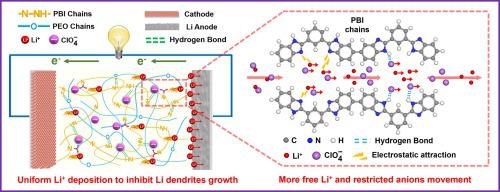Chemical Engineering Journal ( IF 13.3 ) Pub Date : 2023-04-05 , DOI: 10.1016/j.cej.2023.142794 Lei Zou , Kun Shi , Honglei Liu , Yong Wu , Tao Xu , Qiang Wang , Zhangxian Chen , Zeheng Yang , Ru Song , Jianhui Su , Weixin Zhang

|
Polyethylene oxide (PEO)-based solid polymer electrolyte (SPEs) is full of attraction due to its exceptional lithium ion dissolubility and strong resistance toward lithium metal reduction. Nevertheless, it still suffers from the unfulfilling room temperature ionic conductivity and poor mechanical properties. Herein, a flexible and robust polymer-in-salt electrolyte based on composite of polybenzimidazole (PBI) and PEO via a facile preparation approach has been developed for room-temperature lithium metal batteries (LMBs). The rigid framework structure of PBI and dense hydrogen bonds formed between PBI and PEO jointly reinforce the structural stability of SPEs at high lithium salt concentration, which makes the SPEs possess sufficient mechanical properties to resist the lithium dendrites growth. The thermal stability and fire resistance of SPEs have also been improved relying on the distinctive flame retardancy and incombustibility of PBI. Besides, PBI is prone to forming hydrogen bonds with lithium salt anions to limit their mobility, while the rich N atoms on PBI chains can promote the dissociation of lithium salt through electrostatic attraction interaction. Their synergistic effects make the PEO-based polymer-in-salt electrolytes achieve the high room temperature ionic conductivity of 5.7 × 10−4 S cm−1, wide electrochemical window of 4.45 V, and large lithium transference number of 0.639. When applied to LMBs with LiFePO4 or LiNi0.88Co0.06Mn0.06O2 cathode, both coin cells exhibit improved cycling performance and rate capability. Furthermore, the LiNi0.88Co0.06Mn0.06O2/SiOx-C pouch cells using the SPEs demonstrate remarkable flexibility and safety, clarifying that the PEO-based polymer-in-salt electrolytes possess a promising application prospect for safe and high-performance LMBs.
中文翻译:

聚苯并咪唑增强的聚环氧乙烷基聚合物盐电解质可为锂金属电池提供出色的结构稳定性和优异的电化学性能
基于聚环氧乙烷 (PEO) 的固体聚合物电解质 (SPE) 因其出色的锂离子溶解性和对锂金属还原的强大抵抗力而充满吸引力。然而,它仍然存在室温离子电导率低和机械性能差的问题。在此,通过简便的制备方法,开发了一种基于聚苯并咪唑 (PBI) 和 PEO 复合材料的柔性且稳健的聚合物盐电解质,用于室温锂金属电池 (LMB)。PBI 的刚性骨架结构和 PBI 与 PEO 之间形成的致密氢键共同增强了 SPEs 在高锂盐浓度下的结构稳定性,这使得 SPEs 具有足够的机械性能来抵抗锂枝晶的生长。SPEs的热稳定性和耐火性也依靠PBI独特的阻燃性和不燃性得到了提高。此外,PBI易于与锂盐阴离子形成氢键以限制其迁移率,而PBI链上丰富的N原子可通过静电吸引相互作用促进锂盐的解离。它们的协同作用使基于PEO的聚合物盐电解质达到5.7×10的高室温离子电导率-4 S cm -1、4.45 V 的宽电化学窗口和 0.639 的大锂转移数。当应用于具有 LiFePO 4或 LiNi 0.88 Co 0.06 Mn 0.06 O 2阴极的 LMB 时,两种纽扣电池都表现出改进的循环性能和倍率性能。此外,使用SPEs制备的LiNi 0.88 Co 0.06 Mn 0.06 O 2 /SiO x -C软包电池表现出卓越的灵活性和安全性,阐明了基于PEO的聚合物盐电解质具有安全和高性能的广阔应用前景。 LMB。

















































 京公网安备 11010802027423号
京公网安备 11010802027423号